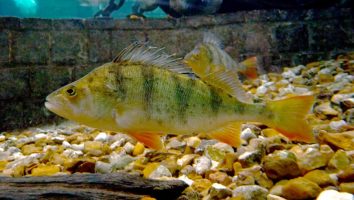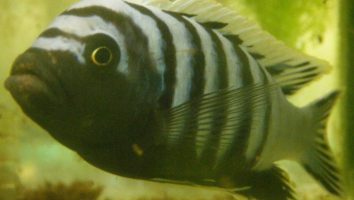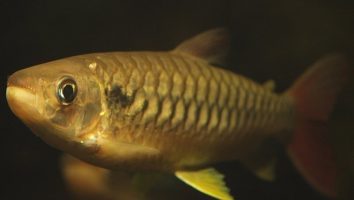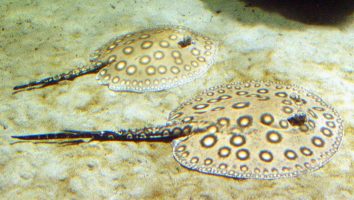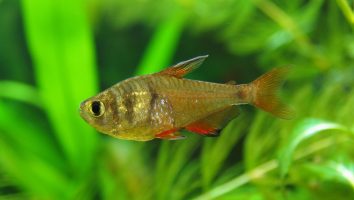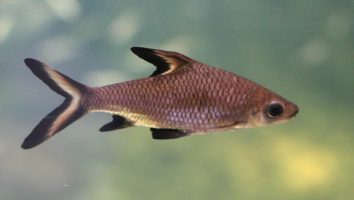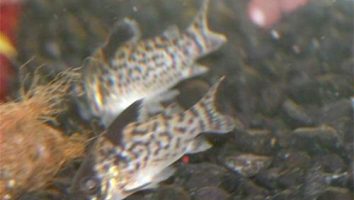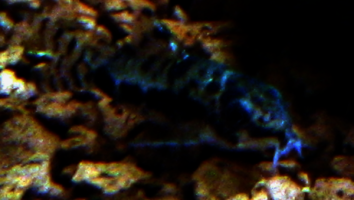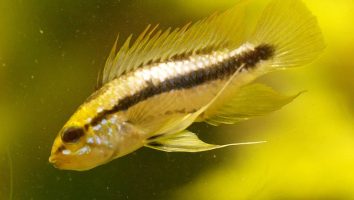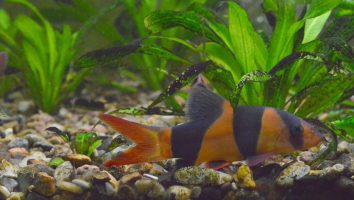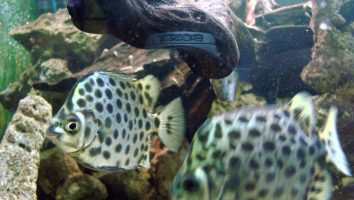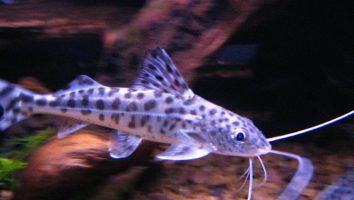Clown Killifish are a beautiful and unique freshwater fish that are perfect for nano tanks.
They’re also one of the few fish that can tolerate brackish water, making them a versatile choice for many different types of aquariums.
But like all fish, they have specific care requirements that must be met in order to thrive. In this guide, we’ll teach you everything you need to know about Clown Killifish care.
You’ll learn about their diet, tank mates, lifespan, and more!
Table of contents
Species overview
Clown Killifish (scientific name: Epiplatys annulatus) are a small freshwater fish that’s native to the coastal regions of West Africa. They are found in countries like Senegal, Guinea, and Sierra Leone.
Clown killifish prefer to live in areas with lots of vegetation and a slow-moving water current. This is something that’s not too difficult to replicate in the average aquarium.
Although they are a small fish, clown killifish are very aggressive toward their own kind. They are also known to be fin nippers, so it’s best to keep them with other fish that are too large to be seen as potential prey.
The Clown Killifish is a popular choice for many aquarium enthusiasts due to its bright coloration and relatively easy care.
Appearance
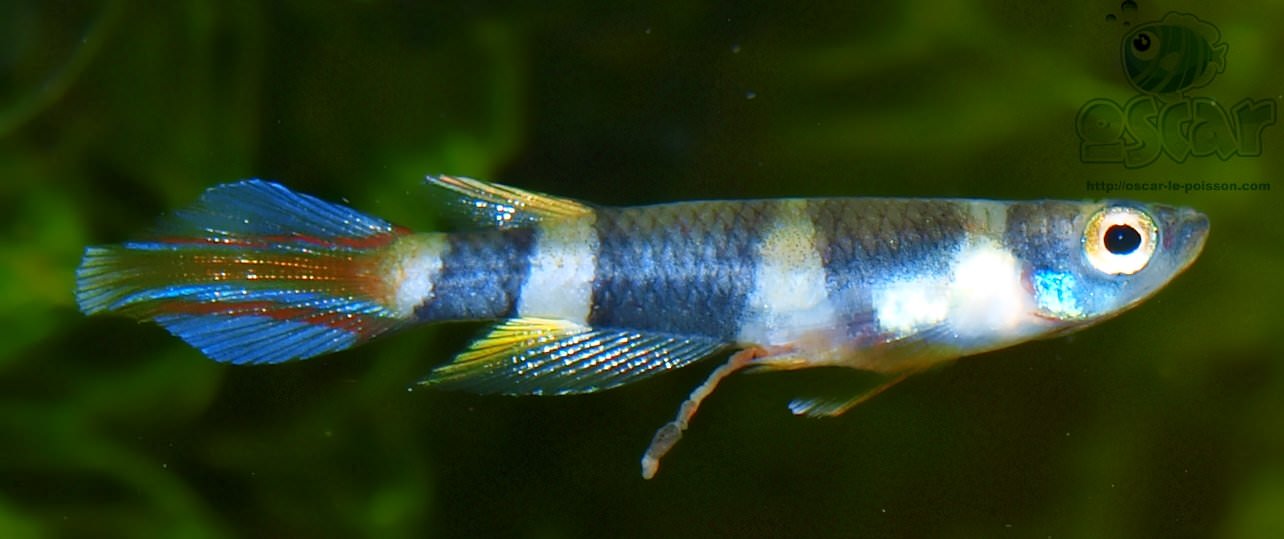
Clown Killifish are one of the most easily recognizable fish in the freshwater world. They have a very distinct appearance that is a result of their coloration and patterns.
The base color of Clown Killifish is a bluish-silver. This color covers the majority of their body with a few exceptions.
On their dorsal half (from head to mid-body), you’ll find a black stripe. This stripe is then flanked on either side by a thinner white stripe.
This pattern repeats itself a few times down the length of their body until it reaches their caudal peduncle. The caudal peduncle is black with a white stripe running down the center.
Clown Killifish have a forked caudal fin that is clear with a black edge. Their dorsal and anal fins are also clear with black edges.
The pectoral fins of Clown Killifish are clear as well.
One of the most unique things about Clown Killifish is their eyes. They have very large eyes that almost take up the entire top half of their head!
These fish also have a very long and thin body shape that is similar to other killifish.
Lifespan
Clown killifish have a lifespan of only 1-2 years in the wild. In captivity, they can live up to 3 years with proper care.
The main reason for their short lifespan is their fast reproduction rate. In the wild, they have so many offspring that the survival rate is very low.
In captivity, we can control their environment better which leads to a longer lifespan.
Size
Clown Killifish reach a maximum size of about 1.5 inches, making them one of the smaller aquarium fish on this list. These fish are very peaceful and can do well in a community tank setup as long as they have plenty of hiding places.
Tank
Tank Size
The minimum recommended tank size for clown killifish is 5 gallons.
While a small fish like this doesn’t need a ton of space, we recommend going with a 10 gallon tank if you can. This will give you some extra space to add other fish or decorations to the tank.
Water Parameters
The clown killifish is a freshwater fish that is found in slow moving streams and stagnant waters in South America.
They are a hardy fish that can tolerate a wide range of water parameters, but it is still important to maintain consistency in the water to keep them healthy.
Here are some guidelines for water parameters:
- Water temperature: 72 to 82 degrees Fahrenheit
- pH levels: 6.0 to 7.5
- Water hardness: 5 to 15 dGH
- Alkalinity Levels: 2 to 12 dKH
What To Put In Their Tank
Clown Killifish are one of the smaller killifish species out there, which means they don’t need a ton of space. A 10-gallon tank is more than enough for a small group of these fish.
With that said, they are still active little swimmers so you don’t want to go too small. A 5-gallon tank would be the bare minimum we’d recommend.
As for the substrate, Clown Killifish don’t really have any preferences. They’re not known to dig around too much so gravel, sand, or even bare-bottom tanks will work just fine.
As for decorations, these fish like to have a lot of hiding spots. Driftwood, rocks, and plants are all great choices. Just make sure that any plants you use can withstand being buried from time to time.
Clown Killifish are known to be jumpers so you might want to consider using a lid on your tank.
Common Diseases
Clown Killifish are a hardy species of fish, but that doesn’t mean they can’t get sick. There are a few diseases that you should be on the lookout for, the most common being ich.
Ich is a very common disease in freshwater fish, and unfortunately, the Clown Killifish is no exception. This disease is caused by a parasite that attaches itself to the fish and begins to feed off of them.
The most obvious symptom of ich is the presence of white spots on the body of the fish. These spots will eventually turn into sores, and if left untreated, ich can be fatal.
Fortunately, ich is relatively easy to treat. There are a number of different medications available that will kill the parasite and allow your fish to recover.
Another disease that you might see in Clown Killifish is hole-in-the-head disease. This disease is caused by poor water quality and the presence of activated carbon in the tank.
It will present itself as one or two pits/holes in the skin of your fish’s head. While it’s almost always curable (fixing your water quality and removing activated carbon is usually all you need to do), it will usually leave some scarring on your poor fish!
Behavior & Temperament
Clown killifish are not social creatures. In fact, they can be downright aggressive with each other. It’s not uncommon for males to fight to the death.
Females are a bit more laid-back, but they’re still not the friendliest fish in the world. If you want to keep more than one clown killifish, you’ll need to provide them with plenty of hiding places.
Clown killifish are also known to be jumpers. They’re not the best swimmers, so when they get startled they tend to make a break for it and jump out of the water. Make sure your tank has a lid to prevent them from escaping.
These fish are predators, so they will go after smaller fish and invertebrates. They’re not picky eaters, either. If it fits in their mouth, they’ll try to eat it.
Tank Mates
Clown killifish are beautiful, peaceful fish that make great additions to any community tank.
They’re not too big and not too small, which gives you a lot of flexibility when choosing tank mates.
Clown killifish are also easy to care for, which is another bonus.
In terms of compatible tank mates, you have a lot of options. These fish do well with other peaceful fish that occupy different areas of the tank.
Some good clown killifish tank mates include:
- Tetras
- Guppies
- Mollies
- Platies
- Swordtails
- Danios
- Corydoras Catfish
Breeding
Clown killifish are easy to care for and even easier to breed. In fact, many breeders consider this species to be the perfect beginner fish. They’re small, low-maintenance, and don’t require a lot of space.
The first step is to set up a breeding tank. It should hold at least 5 gallons of water. Then, you’ll need to add some live plants. Clown killifish like to lay their eggs in the plants.
You don’t need to do anything to the water. Just make sure that it’s clean and free of toxins.
When ready, add two females for every male. Clown killifish are livebearers, so the females will give birth to live fry.
The fry are very small, so you’ll need to feed them live foods. Baby brine shrimp or microworms are a good option. You can also purchase special fry food from your local fish store.
As they grow, you can transition them to flake food. Just make sure that it’s small enough for them to eat.
Conclusion
Clown Killifish are a great addition to any freshwater aquarium. They’re relatively easy to care for and make a great addition to a community tank.
They’re also a lot of fun to watch as they’re very active fish.
If you’re looking for a new fish to add to your tank, we highly recommend the Clown Killifish!

